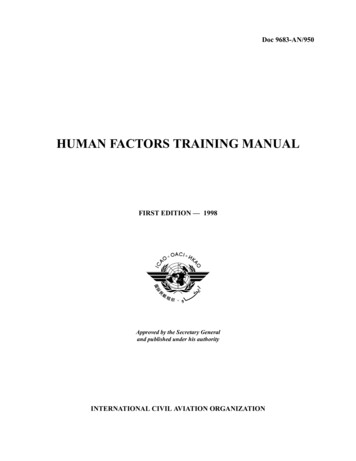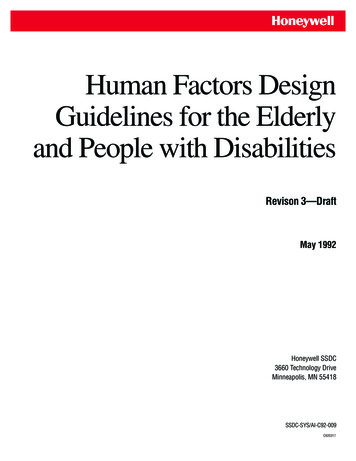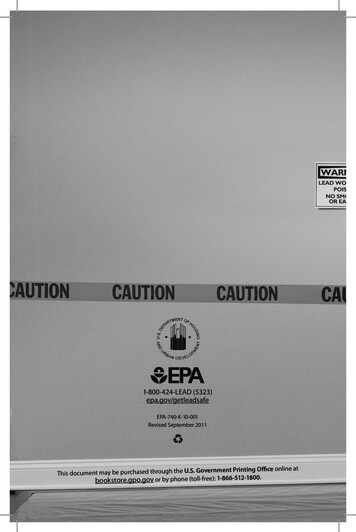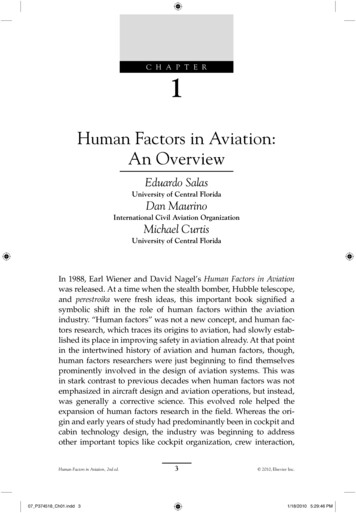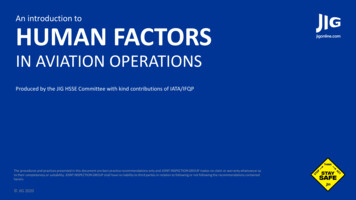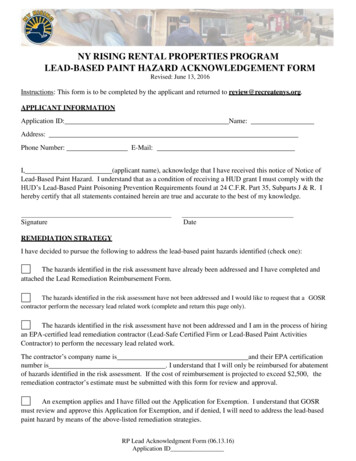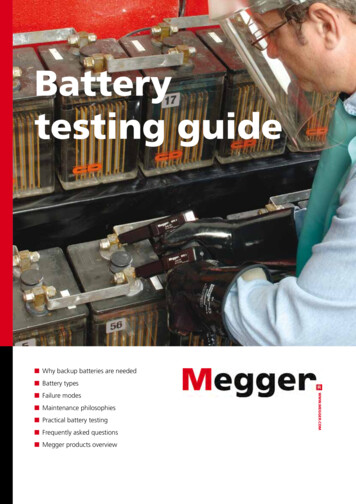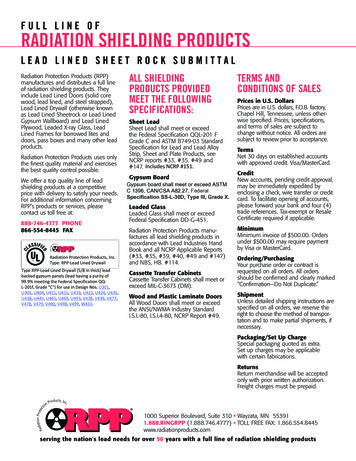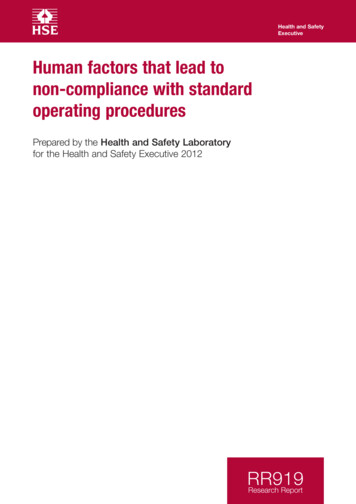
Transcription
Health and SafetyExecutiveHuman factors that lead tonon-compliance with standardoperating proceduresPrepared by the Health and Safety Laboratoryfor the Health and Safety Executive 2012RR919Research Report
Health and SafetyExecutiveHuman factors that lead tonon-compliance with standardoperating proceduresSimon Bates & Justin HolroydHealth and Safety LaboratoryHarpur HillBuxtonDerbyshireSK17 9JNThe Advisory Committee on Dangerous Pathogens categorises biological agents into Hazard Groups 1(negligible hazard) to 4 (highly pathogenic) according to their potential to cause human infection, the likelihoodthat infection could spread in the community, and the availability of effective treatment. For laboratorieswhere biological agents are handled, controls proportionate to these hazards are specified and laboratoriesare designated Containment Levels 1 to 4. These controls are a combination of structural requirements andworking procedures. To protect the health of workers, especially with more pathogenic biological agents, it isimportant that these controls are applied stringently.This report presents results from the Health and Safety Laboratory’s study on the Human Factors that leadto non-compliance with Standard Operating Procedures (SOPs) in Containment Level 3 (CL3) laboratories.The research stemmed from recognition by HSE intervention managers that RIDDOR investigations in CL3laboratories were often identifying non-compliance with SOPs and organisational learning deficiencies ascontributory factors.Understanding the human factors influences on CL3 laboratory workers that could lead to non-compliancewith SOPs will inform HSE HID-SI intervention strategy, thereby helping to drive up safety performancestandards in the CL3 laboratory sector.This report and the work it describes were funded by the Health and Safety Executive (HSE). Its contents,including any opinions and/or conclusions expressed, are those of the authors alone and do not necessarilyreflect HSE policy.HSE Books
Crown copyright 2012First published 2012You may reuse this information (not including logos) free ofcharge in any format or medium, under the terms of theOpen Government Licence. To view the licence nt-licence/,write to the Information Policy Team, The National Archives, Kew,London TW9 4DU, or email psi@nationalarchives.gsi.gov.uk.Some images and illustrations may not be owned by theCrown so cannot be reproduced without permission of thecopyright owner. Enquiries should be sent tocopyright@hse.gsi.gov.uk.ACKNOWLEDGEMENTSThe authors would like to thank the organisations and theirstaff who participated in the focus groups, without whom thisresearch would not have been possible.ii
KEY MESSAGES The reasons for cutting corners and the situations where cutting corners could be morelikely were mainly found to be due to situational and organisational factors. Forexample, time pressure, workload, staffing levels, training, supervision, and availabilityof resources. Controls to address situational and organisational issues, and promote compliance withSOPs, were found to be wide ranging. For example, predicting peaks in demand,planning a realistically achievable workload, and engendering an organisational culturewhere staff feel able to challenge management pressure Participants reported a particular ‘type’ of person, described as being conscientious,patient, willing to comply, and confident but not overconfident, as being best suited toCL3 laboratory work. The SOP systems and documents were reported to be generally usable and fit forpurpose. Participants reported a number of features of their SOPs that reflect theliterature on accepted good practice, for example, inclusion of visual aids. Participant laboratories all reported having internal systems for capturing informationfrom near misses and incidents and the capacity to learn from those experiences. Somelaboratories had a more comprehensive system for sharing information with otherlaboratories than others. Whilst some differences were apparent in the findings from the various classificationsof CL3 laboratories involved in this research (research laboratories, diagnosticlaboratories, human pathogens, animal pathogens, genetic engineering), no significantdifferences in the main issues emerged.iii
iv
EXECUTIVE SUMMARYIntroductionThe Advisory Committee on Dangerous Pathogens categorises biological agents into HazardGroups 1 (negligible hazard) to 4 (highly pathogenic) according to their potential to causehuman infection, the likelihood that infection could spread in the community, and theavailability of effective treatment. For laboratories where biological agents are handled,controls proportionate to these hazards are specified and laboratories are designatedContainment Levels 1 to 4. These controls are a combination of structural requirements andworking procedures. To protect the health of workers, especially with more pathogenicbiological agents, it is important that these controls are applied stringently.This report presents results from the Health and Safety Laboratory’s study on the HumanFactors that lead to non-compliance with Standard Operating Procedures (SOPs) inContainment Level 3 (CL3) laboratories. The research stemmed from recognition by HSEintervention managers that RIDDOR investigations in CL3 laboratories were often identifyingnon-compliance with SOPs and organisational learning deficiencies as contributory factors.Understanding the human factors influences on CL3 laboratory workers that could lead to noncompliance with SOPs will inform HSE HID-SI intervention strategy, thereby helping to driveup safety performance standards in the CL3 laboratory sector.MethodSix focus groups were carried out across a range of laboratories that reflect the variety ofcontexts of the CL3 laboratory sector. Data gathered in the focus groups was subject to arigorous thematic analysis and findings were compared to the literature on accepted goodpractice for the human factors that relate to non-compliance with SOPs.Main findingsThe SOPs were reported to be, in the main, usable and fit for purpose. Procedures were said tobe up-to-date, contained the right level of detail, and reflected how the tasks were performed.Staff also said they were involved in the development of procedures to ensure they were alignedwith the practicalities of carrying out the work.In terms of compliance, a number of reasons and situations were highlighted where cornerscould be cut. These were primarily situational in nature, relating to organisational factorswithin the scope of management to influence, for example, time pressure, workload, staffinglevels, training, supervision, and availability of facilities were common themes across the sixfocus groups. On an individual level, the findings suggest that a particular ‘type’ of personcould be best suited to CL3 laboratory working. Such an individual was described as beingconscientious, patient, willing to comply, and confident but not overconfident. Optimisingviolations were not apparent in the data, which indicates that CL3 laboratory workers are notcutting corners as a result of a need for excitement in their jobs.Controls to address situational and organisational issues include workload and timemanagement, booking timeslots on CL3 facilities, and challenging the pressure fromv
management. Predicting peaks in demand and planning a realistically achievable workload wasreported as likely to have a positive impact on compliance with SOPs. An organisationalculture where staff feel able to challenge management pressure was reported to be an importantfactor in compliance with SOPs. A progressive management approach should recognise thisand be mindful that short-term productivity gains could compromise health and safety and setthe tone within the work environment where non-compliance with SOPs may become theaccepted way of working in order to get the work done in the time available.Whilst some differences were apparent in the findings from the various classifications of CL3laboratories involved in this research, no significant differences in the main issues emerged.Indeed, the reported ‘reasons for cutting corners’ and ‘situations where cutting corners may bemore likely’ were familiar from research in other industry sectors. This suggests that CL3laboratories experience similar challenges to other sectors where compliance with safety criticalprocedures is a common feature of the work. This is a view supported by the research literature.Laboratories that took part in this research all have internal systems for capturing informationfrom near misses and incidents, and learning from those experiences. Whilst this is an acceptedapproach for development, and is supported by the literature, there is potential benefit in thewider communication of information with other laboratories.Future directionsIn order to maintain and progress compliance with SOPs, CL3 laboratories should continue withthe controls they already have in place but with a particular focus on controls relating tosituational violations, as this was the most common area of non-compliance. As situationalcontrols are correlated with organisational factors, it is likely that management will have moreinfluence than laboratory workers. Efforts should therefore be made by management in CL3laboratories, with support from the regulator, towards engendering a management approach thatbuilds on existing good practice and focuses on the various situational and organisational factorsdescribed in this research (for example, workload planning, realistic time scheduling, andavailability of resources) in order to maintain compliance with SOPs and, therefore, maintainhealth and safety standards across the industry.vi
CONTENTS PAGE1. INTRODUCTION . 11.11.21.31.41.51.6Human 4442. IMPLICATIONS . 53. METHODOLOGY . 73.13.23.33.43.53.6Study designSampling strategy and recruitmentPreparation of vignettesQualitative data collectionData analysisLiterature search7778994. FINDINGS . Main risksStandard Operating ProceduresPerceptions of risk controls and safety management systemsHuman Factors (non)-compliance with SOPsOrganisational learning and communicationFindings from the review of targetted literatureLimitations1010101012161820235. CONCLUSIONS . 255.15.25.35.45.5Cutting corners – reasons and situationsFollowing procedures – ease and difficultyWhat can be done to improve compliance with SOPs?Organisational learning and communicationFuture directions25262727286. REFERENCES . 297. ANNEXES. 307.17.27.37.47.57.6Annex 1 – Recruitment script for potential participant CL3 laboratoriesAnnex 2 – Covering letter for Biological Safety OfficersAnnex 3 – Information document for focus group participantsAnnex 4 – Consent form for focus group participantsAnnex 5 – Vignettes for use in the focus groupsAnnex 6 – Topic guide for use in the focus groups303133343538vii
viii
1. INTRODUCTIONThe Advisory Committee on Dangerous Pathogens (ACDP) is an expert body comprising ofrepresentatives from HSE, other Government agencies and academic scientists. Its purpose is torecognise and advise on measures to control the risks of human infection in the workplace andwider impacts on public health. ACDP categorises biological agents into Hazard Groups 1(negligible hazard) to 4 (highly pathogenic) according to their potential to cause humaninfection and the likely consequences were an infection to occur. For laboratories wherebiological agents are handled, controls proportionate to these hazards are specified andlaboratories are designated Containment Levels 1 to 4. These controls are a combination ofstructural requirements and working procedures. These are described in detail in the ACDPpublication ‘The management, design and operation of microbiological containmentlaboratories’1. This guidance explains the legal requirements set out in the biological agentsprovisions of COSHH (Control of Substances Hazardous to Health Regulations 2002 (asamended)8), with particular attention to how these requirements influence the design,construction and operation of laboratories. To protect the health of workers and others,especially with more pathogenic biological agents, it is important that these controls are appliedstringently.In reviewing RIDDOR (Reporting of Injuries, Diseases and Dangerous OccurrencesRegulations) investigations, as well as other types of failures in the Biological Agents sectorthat result from the failure of a dutyholder to comply, HSE intervention managers had noticedthat problems often appear to arise from a failure to follow Standard Operating Procedures(SOPs), or else dutyholders do not appear to be learning from the causes of events and applyinglessons to other parts of the organisation that are within the dutyholders’ purview. This sort offailure falls into the scope of ‘human factors’.HSL Human Sciences Unit had recently conducted research into risk taking behaviour inContainment Level 4 Laboratories11, but specific peer reviewed analysis of non-compliantbehaviour was not within the scope of this work. Therefore to build upon the knowledge of thisarea HSE commissioned HSL to determine the human factors that lead to non-compliance withSOPs incidents at Containment Level 3 (CL3) laboratories in Great Britain. The findings fromthis research will be used to inform future HID-SI (Hazardous Installations Directorate –Specialised Industries) intervention strategy, thereby helping to reduce the number of futureincidents.1.1HUMAN FACTORSHSE has published key guidance documents on the topics of human factors and human failures,for example, HSG48 – Reducing error and influencing behaviour3. From this guidance, HSEoffer a definition of human factors:Human factors refer to environmental, organisational and job factors, and human andindividual characteristics which influence behaviour at work in a way which can affect healthand safety.1
1.2PROCEDURESHSG48 covers a number of broad topics relating to human factors in the workplace with a viewto assisting organisations to drive up health and safety performance by controlling the impact ofhuman factors. One such topic is (Standard Operating) Procedures, and HSG48 states:Procedures, especially operating and maintenance procedures, are important for the preventionof accidents and ill health. Written procedures are vital in maintaining consistency and inensuring that everyone has the same basic level of information. They are a key element of asafety management system and an important training tool. However, poor procedures can be areason for people not following recommended actions.Procedures ideally need to: Be accurate and complete; Be clear and concise with an appropriate level of detail; Be current and up to date; Be supported by training; Identify any hazards; State necessary precautions for hazards; Use familiar language; Use consistent terminology; Reflect how tasks are actually carried out; Promote ownership by users; Be in a suitable format; and Be accessible.It is widely accepted that procedures play a vital role within organisations, for example, inrelation to maintaining quality, health and safety, and consistency of outcomes. There ishowever a body of evidence that indicates that the root cause of accidents can often be tracedback to procedures not having been followed. Examples of major accidents where noncompliance with Procedures was a contributory factor include Chernobyl (1986), Piper Alpha(1988), and Clapham Junction (1988). In human factors terms, when a worker acts in a way notconsistent with SOPs, and the action was intentional, then this non-compliance is referred to asa ‘violation’. This does not mean that the action was malicious in nature, rather that theindividual believed that the action was, for some reason, justified.1.3VIOLATIONSHSE recognises that the underlying causes of procedural violations are not wholly theresponsibility of the frontline worker, and that management have a key role to play in ensuringwork is carried out in accordance with SOPs.2
Violations are highly susceptible to management influence, as most underlying causes ofviolations are created by management, accepted by management or condoned as normalworking practice by management neglect.4Further to this, HSE offers a useful definition of violations as being:Any deliberate deviations from the rules, procedures, instructions and regulations drawn up forthe safe or efficient operation and maintenance of plant or equipment.5.Within the human factors literature, violations are often categorised as routine violations,situational violations, exceptional violations and optimising violations. These categories areoutlined in the following sections.1.3.1Routine violationsA routine violation is a behaviour in opposition to the rule, procedure or instruction that hasbecome the normal way of behaving within the person’s peer/work group. The violatingbehaviour is normally automatic and unconscious. The violation is recognised as such by theindividual, if questioned.41.3.2Situational violationsA situational violation occurs because of factors dictated by the employee’s immediateworkspace or environment.4These include: Design of the work area; Condition of the work area; Time pressure; Staffing levels; Supervision; Equipment availability; Equipment design; Other factors outside the organisation’s control are also included here, for example,weather and time of day.1.3.3Exceptional violationsExceptional violations are rare and happen only in particular circumstances, often whensomething goes wrong. They occur to a large extent when an individual is attempting to solveproblems in unusual situations. The individual, in attempting to solve new problems, violates a3
rule to achieve the desired goal. These violations are commonly associated with high risk, oftenbecause the consequences of the action are not fully understood or because the violation isknown to be dangerous but seems inescapable.41.3.4Optimising violationsOptimising violations are created by a motive to optimise a work situation. These violations areusually caused through a need for excitement in jobs which are considered repetitive,unchallenging or boring, a desire to explore the boundaries of a system which are thought to betoo restrictive, or pure inquisitiveness.41.4ERRORSTo complete the picture, a further category of human failures exists that may result in a workoutcome inconsistent with that which the SOPs guide towards. This type of human failure istermed ‘human error’. Human errors are actions or decisions that deviate from an acceptedstandard and result in an undesirable outcome. Human errors are unintentional and categorisedinto skill-based errors (slips and lapses) and mistakes (rule-based and knowledge-based).The focus of this work is on non-compliance with SOPs, which is a violation issue rather thanan error issue. This brief description of error has been included to complete the picture in termsof the generally accepted model of human failure.1.5AIMSThe aims of this research were to: Identify the key human factors that influence the non-compliant behaviour of staffworking in CL3 laboratories (specifically why they fail to follow the SOPs). Determine the control measures/barriers that can be applied to reduce such behaviours.1.6OBJECTIVESThe objectives of this research were to: Review RIDDOR and Accident Investigation reports to inform the content of vignettes(short stories or scenarios) for use in focus groups (semi-structured group discussions)with CL3 laboratory staff. Conduct focus groups and interviews to collect data to address the aims. Analyse data collected to determine the types of human factors that underlie noncompliant behaviour at CL3 laboratories. Conduct a small literature review to establish the sorts of control measures that may beutilised to reduce the likelihood of such incidents in the future.4
2. IMPLICATIONS The reasons for, and situations where, corners could be cut were primarily found to besituational in nature and related to organisational factors within the commonly acceptedframework of human factors. This being the case, CL3 laboratory management aremore likely to be able to influence these factors, for example, time pressure, workload,staffing levels, training, supervision, and availability of resources, than CL3 laboratorystaff. With respect to these issues, the challenges faced by CL3 laboratories are similarto other sectors where compliance with SOPs is a common feature of the work, and is aview supported by the literature. Controls to address situational and organisational issues include workload and timemanagement, booking timeslots on CL3 facilities, and challenging the pressure frommanagement. Predicting peaks in demand and planning a realistically achievableworkload was reported as likely to have a positive impact on compliance with SOPs.CL3 laboratory management should aim to effectively manage resources such that theycreate the optimal conditions for SOPs to be adhered to. An organisational culture where staff feel able to challenge management pressure wasreported to be an important factor in compliance with SOPs. Management should bemindful that short-term productivity gains could compromise health and safety. Localleadership could set the tone within the work environment where non-compliance withSOPs may become the accepted way of working. CL3 laboratory management shouldstrive to ensure this does not happen. On an individual level, participants reported a particular ‘type’ of person, described asbeing conscientious, patient, willing to comply, and confident but not overconfident, asbeing best suited to CL3 laboratory work. This could inform a targeted approach torecruitment and selection. The SOPs themselves were reported to be, in the main, usable and fit for purpose. Ausable index structure and inclusion of visual aids were said to make it easier to workwith SOPs. Overly lengthy SOPs containing perceived unnecessary detail andelectronic SOP systems that were perceived as impractical and slow were said to makeit more difficult to work with SOPs. These findings correlate with the literature onaccepted good practice. Those writing the SOPs should refer to good practice guidanceon writing procedures in order to maintain a usable SOP system and promotecompliance. Participant CL3 laboratories all had internal systems for capturing information fromnear misses and incidents and the capacity to learn from those experiences. Potentialgains could accrue from the wider communication of near miss and incident informationwith other laboratories, with a view to driving up standards across the sector by learningfrom others’ experiences and control approaches. The information-sharing modelimplemented by the HPA appears to be a useful template for such a strategy. HSE mayalso be able to facilitate sharing of information. Care should be taken with extrapolation of the findings of this research to the widerpopulation of CL3 laboratories due to the nature of qualitative research and thepossibility that the current sample may not be representative of the population of CL3laboratories in Great Britain. However, as the findings are broadly in line with findingsfrom research into the underlying causes of procedural violations in other industry5
sectors, it could be hypothesised that the reasons and situations put forward byparticipants in this research regarding why and when they may not follow SOPs couldalso be evident in other CL3 laboratories.6
3. METHODOLOGY3.1STUDY DESIGNThis study aimed to draw upon the contextual insights of staff working in CL3 laboratories.Therefore, a qualitative research methodology was deemed appropriate to gather and analyse theviews of subject matter experts by conducting a series of focus groups. This methodology waschosen because the objectives of the study required a detailed exploration of the views andexperiences of participants. Vignettes (hypothetical short stories or scenarios) were used in thefocus groups to allow participants to talk openly about the salient issues without needing to referdirectly to their own actions.In addition to the focus groups, a brief literature review was conducted to determine controlmeasures that may help address non-compliance with SOPs.3.2SAMPLING STRATEGY AND RECRUITMENTA purposive sample of six CL3 laboratories was selected from the 759 CL3 laboratories inGreat Britain, to include the five key areas of operation as outlined in Table 1.Table 1: The five key areas of CL3 laboratory operations in the research sampleResearch laboratoriesDiagnostic laboratoriesHuman pathogensHuman pathogensAnimal pathogensAnimal pathogensGenetic engineeringHSE colleagues supplied contact details of potential participant laboratories, drawing onestablished industry contacts (specifically BSOs (Biological Safety Officers)) from a range oforganisations operating CL3 laboratories. HSL staff undertook the recruitment of participantlaboratories using the prepared recruitment script (see Annex 1). Following a verbal descriptionof the research, the BSOs from the potential participant laboratories were sent additionalinformation in the form of a covering letter (see Annex 2), an information document (see Annex3), and consent form for the focus group participants (see Annex 4).3.3PREPARATION OF VIGNETTESVignettes have been described as “short stories about hypothetical characters in specifiedcircumstances, to whose situation the interviewee is invited to respond”2. Vignettes werechosen for use at the focus groups because they facilitate swift participant understanding of the7
topic of interest and allow information to be elicited without participants having to admit thatthey have not followed the SOPs themselves.A review of RIDDOR reports and Accident Investigation reports informed the development ofthe vignettes. The two sources of information on incidents were explored to identify relatedthemes that were then used to inform the content of the vignettes.The vignettes were subject to an iterative review process during their development. Reviewersincluded internal HSL microbiology specialists and external Biological Safety Officers (BSOs).This process ensured that the final versions of the vignettes were valid and containedappropriate content that would elicit relevant and informative data. A total of ten vignettes weredeveloped and up to three were selected for each focus group session, based on relevance to theorganisation. The vignettes can be found at Annex 5.3.4QUALITATIVE DATA COLLECTIONTwo HSL researchers facilitated the six focus groups. All focus groups were audio recorded,with the consent of all participants. Participants were given assurances of the confidentialityand anonymity of the information being collected. The lead researcher facilitated the focusgroup sessions, guiding the discussion through the topics as set out in the topic guide (seeAnnex 6) and accommodating relevant departures from the prepared questions whereappropriate. The second researcher took written notes to back-up the audio recordings.The audio recordings from the six focus groups were transcribed verbatim by an externalcontractor, and checked by the lead researcher. Any notes from the focus groups were used tosupplement the verbatim transcripts.Table 2: Focus group detailsDateLaboratory type categoryNumber of participants19/5/11Research laboratory – Human pathogens624/5/11Diagnostic laboratory – Human pathogens725/5/11Diagnostic laboratory – Human pathogens427/5/11Research laboratory – Animal pathogens57/7/11Diagnostic laboratory – Animal pathogens528/7/11Research laboratory – Genetic engineering88
3.5DATA ANALYSISData collected in the focus groups was analysed using a systematic approach as advocated bythe National Centre for Social Research14. This approach develops, refines and modifies ananalytic (or thematic) framework, into which every piece of data is then systematically andconsistently analysed. The analytical framework was initially informed by the researchobjectives, research topics in the focus group topic guide, and by the key issues that emergedfrom the data. The framework was grounded in the data and not imposed by the researcher. Amatrix of themes and sub-themes was derived from the data, which was then used to explore,and to compare and contrast, the patterns of responses in the data. The data analysis resulted inthe identification of a number of key issues concerning the human factors that lead to noncompliance with SOPs in CL3 laboratories.3.6LITERATURE SEARCHFollowing analysis of the focus group data and having established the types of human factorsthat result in non-compliance with SOPs in CL3 laboratories, a brief targeted literature searchwas carried out. This was to identify the control measures that may be effectively employed toreduce the likelihood of such non-compliances in the future (for example, barriers that havebeen tried and tested by other organisations from various industries and those that arerecognised by HSE as good practice). The literature search used the terms Biohazard, CL3laboratory, human factors, standard operating procedures, non-compliance, violations, andcutting corners.
Understanding the human factors influences on CL3 laboratory workers that could lead to non-compliance with SOPs will inform HSE HID-SI intervention strategy, thereby helping to drive up safety performance standards in the CL3 laboratory sector. This report and the work it describes were funded by the Health and Safety Executive (HSE). Its .
